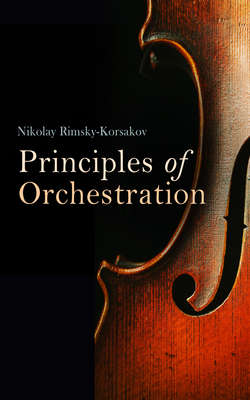Читать книгу Principles of Orchestration, with Musical Examples Drawn from His Own Works - Rimsky-Korsakov Nikolay - Страница 10
На сайте Литреса книга снята с продажи.
ОглавлениеNote I. Composers using the first class in the course of a big work (oratorio, opera, symphony, etc.) may introduce special instruments, called extras, for a long or short period of time; each of these instruments involves an extra player not required throughout the entire work. Meyerbeer was fond of doing this, but other composers, Glinka for example, refrain from increasing the number of performers by employing extras (Eng. horn part in Rousslân). Wagner uses all three classes in the above table (in pair's: Tannhäuser—in three's: Tristan—in four's: The Ring).
Note II. Mlada is the only work of mine involving formation by four's. Ivan the Terrible, Sadko, The Legend of Tsar Saltan, The Legend of the Invisible City of Kitesh and The Golden Cockerel all belong to the second class, and in my other works, wood-wind in pair's is used with a varying number of extras. The Christmas Night, with its two oboes, and two bassoons, three flutes and three clarinets, forms an intermediate class.
Considering the instruments it comprises, the string group offers a fair variety of colour, and contrast in compass, but this diversity of range and timbre is subtle and not easily discerned. In the wood-wind department, however, the difference in register and quality of flutes, oboes, clarinets and bassoons is striking to a degree. As a rule, wood-wind instruments are less flexible than strings; they lack the vitality and power, and are less capable of different shade of expression.
In each wind instrument I have defined the scope of greatest expression, that is to say the range in which the instrument is best qualified to achieve the various grades of tone, (forte, piano, cresc., dim., sforzando, morendo, etc.)—the register which admits of the most expressive playing, in the truest sense of the word. Outside this range, a wind instrument is more notable for richness of colour than for expression. I am probably the originator of the term "scope of greatest expression". It does not apply to the piccolo and double bassoon which represent the two extremes of the orchestral compass. They do not possess such a register and belong to the body of highly-coloured but non-expressive instruments.
The four kinds of wind instruments: flutes, oboes, clarinets and bassoons may be generally considered to be of equal power. The same cannot be said of instruments which fulfil a special purpose: piccolo, bass flute, Eng. horn, small clarinet, bass clarinet and double bassoon. Each of these instruments has four registers: low, middle, high and extremely high, each of which is characterised by certain differences of quality and power. It is difficult to define the exact limits of each register; adjacent registers almost blend together and the passage from one to another is scarcely noticeable. But when the instrument jumps from one register to another the difference in power and quality of tone is very striking.
The four families of wind instruments may be divided into two classes: a) instruments of nasal quality and dark resonance—oboes and bassoons (Eng. horn and double bassoon); and b) instruments of "chest-voice" quality and bright tone—flutes and clarinets (piccolo, bass flute, small clarinet, bass clarinet).
These characteristics of colour and resonance—expressed in too simple and rudimentary a form—are specially noticeable in the middle and upper registers. The lower register of the oboes and bassoons is thick and rough, yet still nasal in quality; the very high compass is shrill, hard and dry. The clear resonance of the flutes and clarinets acquires something nasal and dark in the lower compass; in the very high register it becomes somewhat piercing.
